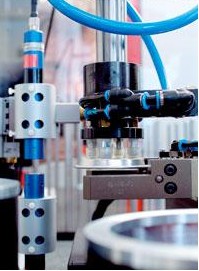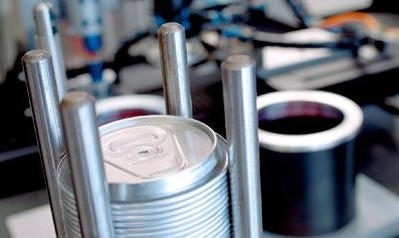Quality inspection of beverage can production
Cans made of aluminum alloy material weighs only 13g As a kind of packaging, people put forward the highest requirements for the quality of cans: oxygen and air should not leak into it, ensuring that the beverages in the cans are not affected by the outside world. It has the highest compression stability compared to other beverage packaging: although it is as thin as the hairline, it can withstand pressures up to 6 bar. In the past year, the environmental performance of this can has been significantly improved: by reducing the recycling of metal materials, the same material can now produce three times more cans than 30 years ago. Further weight reduction and optimization of the production process also ensure the sustainable development of can production. Ball Packaging Europe (BPE) tests the weight and safety of its metal packaging in its own technical center in Berne. The mission of the experts at the Bourne Technology Center is to ensure the quality of the cans in further development to reduce the weight of the can bodies and can ends (Fig. 1). Different test and analysis techniques for the simulation of cans were used in the inspection of cans. The standardized drop test tests the mechanical properties of the cans by dropping them at different heights. After the fall, the cans must not be cracked or broken. Depressions within the specified allowable size range are possible because this is due to the pressure safety of the can, and it is expected that it can be secured by its own dent deformation. Therefore, the can bottom and the can lid are designed and manufactured to ensure that they do not burst due to a sudden increase in pressure inside the can. Figure 1 In the technical center of Bourne, Ball Packaging Europe, testing and testing of cans are being carried out. Danger caused by defects Figure 2 The cans provide excellent protection for the beverage inside, ensuring the reliability of long-term storage of the beverage. Have huge potential for mining 
The ability of the anti-corrosion coating in the can to resist damage when the cans are recessed is detected using the Can Abuse Resistance Test. During this test, the laboratory inspectors examined whether the porosity of the coating material in the can was changed under the action of mechanical external forces. Similar to the drop test, the cans were also dropped from different heights in the Cart test. The inside of the can after the drop test was examined using a microscopic magnification device to see if the internal coating changed after the fall. Even small cracks or changes in porosity should be avoided because their defects can adversely affect the beverage in the can. Cans are produced by different deformation processes. In their production process, the axial strength, ie the stability of the centerline of the can, was also tested within the framework of quality assurance. The unit of force at the time of detection is N, the pressure unit inside and outside the can is taken as bar, and the current intensity unit in the internal coating integrity test is mA.
In order to be able to directly direct the production test results, there is a test canning line in the technical center. Due to the small production volume of this manually controlled filling line, which cannot be compared with the filling line of beverage manufacturers, the production conditions are almost the same: the canned capacity per hour is 120,000 cans. The working parameters that affect the quality of cans are exactly the same as the actual production process: canning height and sealing accuracy (Figure 2). 
In addition to testing the quality of cans, experts in the technical center also research and develop the manufacturing process technology of cans. And decisive technical improvements are often inseparable from close cooperation with users. For example, they developed Widget technology with Diageo, a world-renowned beverage manufacturer. The surface of the beer poured out of the can is capable of floating the foam for a long time by means of a capsule which produces a large amount of foam. Diageo has rapidly expanded their beer market with this Widget can. BPE has further improved this technology on this basis. Today, it has been successfully applied to dairy cans, such as the famous Italian coffee drink cappuccino. For a long time, the potential of cans has not been fully tapped. Especially in the new electronic label technology, secondary sealing applications, etc. will win a wider market for cans in the next few years. The mission of BPE Technology Center experts is consistent: to ensure quality and to ensure the environmental performance of cans.
Cans production process
â— Apply a layer of lubricating oil to the surface of the white iron to ensure the smooth progress of the stamping process. In the stamping deformation process, excess white iron is gradually cut out and gradually punched into a disc shape.
â— The disc-shaped can blank is sent to the drawing machine. Under the action of the punch and the pressing plate, the diameter of the disc-shaped blank is gradually reduced, the thickness of the iron plate is kept constant, and finally the diameter of the punch is reduced. In order to avoid wrinkles in the tube wall during the drawing process, the disk-shaped blank is pressed with a pressure plate. The gap between the drawing die and the drawing punch is just the size required for the wall thickness of the finished can, so that the disk-shaped blank having a larger thickness is drawn into a barrel-shaped cylinder having a thin wall thickness. At the end of this process, the bottom stamping die also stamps the shape of the bottom of the can. After the punch is retracted, the demolding device retracts the can attached to the punch and outputs it to the outside of the drawing machine.
â— In the can cutting machine, the vacuum suction cup firmly holds the can semi-finished product and drives it to rotate together; it also moves along the axis until it reaches the height required for the can. The cutter for cutting the cans feeds the rotating can blank. When the cans are rotated for one revolution, the upper and lower cutting tools cut the cans to the desired height.
â— Then it is the cleaning of cans, external pattern spraying, embossing, drying and spraying of internal protective coatings.
â— In order to install the can lid with a small diameter, the upper part of the cylindrical can is also "reduced", that is, the diameter of the upper part of the can is reduced by the calendering process. The cylindrical can is placed on the mandrel, and while the mandrel moves axially, the upper portion of the can is gradually compressed and reduced in the reduced diameter mold, and the diameter of the can is contracted by about 1 mm. After the shrinkage of the diameter is completed, the mandrel is retracted, and the can is blown out of the mandrel by compressed air.
â— The subsequent crimping is the key to ensuring a reliable combination of the cans with the beverage and the can lid. This process is done on the crimping machine. The upper mouth of the can is finished under the action of a plurality of crimpers, and the beading is completed during the rotation of the can.
â— Finally, the spray paint on the bottom of the can and the second inner protective layer are sprayed, as well as the final leak test, crimp crack test and internal defect check.
